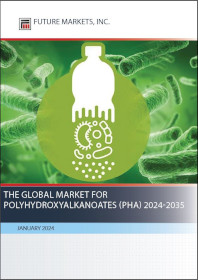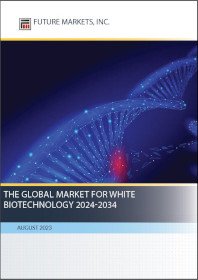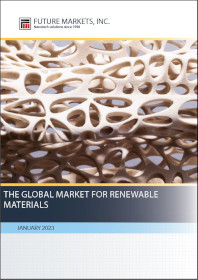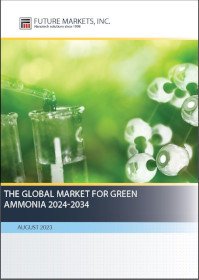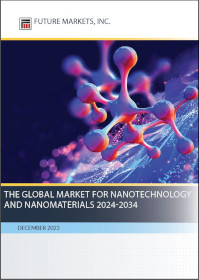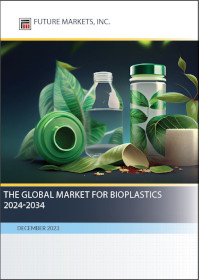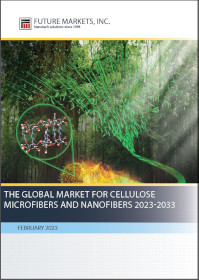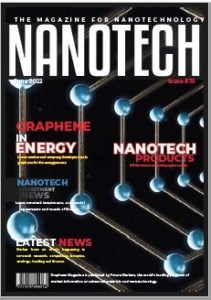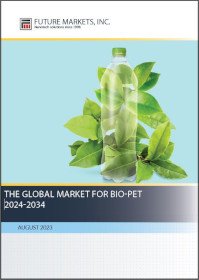 Published August 2023 | 106 pages, 26 tables, 31 figures | Download table of contents
Published August 2023 | 106 pages, 26 tables, 31 figures | Download table of contents
Global Bio-PET Market Set for Rapid Growth Driven by Sustainability Trends and Plant-Based Plastic Demand
Bio-PET, a bioplastic derived from plant-based materials, enables brands to adopt renewable and circular alternatives to fossil fuel-based PET. Driven by sustainability, this report forecasts the bio-PET market will exceed 2.5 million tons by 2034, with packaging as the dominant application.
As sustainability initiatives gain momentum, interest in bio-based plastics like bio-PET has surged. Bio-PET provides a drop-in replacement for conventional PET derived from fossil fuels. It offers a renewable solution as brands aim to reduce their environmental impact and carbon footprint.
Made from plant-based monoethylene glycol (MEG), bio-PET is chemically identical to PET but has the advantage of coming from renewable sources. It is easy to implement in existing PET products and recycling streams.
Key Growth Factors:
- Consumer preference shifting toward eco-friendly products
- Brands across industries announcing sustainability commitments
- Favorable government policies and regulations around bio-based materials
- Advances in bio-PET production technologies and capacity
Market Outlook and Forecasts
Driven by packaging, the global bio-PET market is projected to reach over 2.5 million metric tons by 2034. Asia Pacific leads production and consumption. This section provides detailed forecasts segmented by end-use industry and region.
As brands respond to consumer and regulatory pressure to adopt renewably-sourced materials, bio-PET is positioned for steep growth trajectories over the coming decade.
Major Players Driving Adoption
The Global Market for Bio-PET 2024-2034 includes comprehensive company profiles of 27 companies. Companies profiled include Hyosung Advanced Materials, Indorama Ventures, NatureWorks, Toray, Teijin, and Origin Materials. Company profiles include products, target markets, funding, and recent market activity.
PDF download and print edition (including tracked delivery).
Payment methods: Visa, Mastercard, American Express, Paypal.
To purchase by invoice (bank transfer) or in an alternative currency please contact info@futuremarketsinc.com or select Bank Transfer (Invoice) as a payment method at checkout.
1 EXECUTIVE SUMMARY 9
- 1.1 Market drivers and trends in bioplastics and biopolymers 10
- 1.2 Global production to 2034 12
- 1.3 Main producers and global production capacities 14
- 1.3.1 Producers 14
- 1.3.2 By biobased and biodegradable plastics type 15
- 1.3.3 By region 18
- 1.4 Global demand for Biobased and Biodegradable Plastics (Bioplastics), by market 19
- 1.5 Challenges for the Biobased and Biodegradable Plastics (Bioplastics) market 22
- 1.6 The Global bio-PET market 23
2 RESEARCH METHODOLOGY 24
3 THE GLOBAL PLASTICS MARKET 25
- 3.1 Global production of plastics 25
- 3.2 The importance of plastic 25
- 3.3 Issues with plastics use 26
- 3.4 Policy and regulations 26
- 3.5 The circular economy 27
- 3.6 Conventional polymer materials used in packaging 29
- 3.6.1 Polyolefins: Polypropylene and polyethylene 30
- 3.6.2 PET and other polyester polymers 32
- 3.6.3 Renewable and bio-based polymers for packaging 32
- 3.7 Comparison of synthetic fossil-based and bio-based polymers 34
- 3.8 End-of-life treatment of bioplastics 34
4 THE GLOBAL BIOPLASTICS MARKET 37
- 4.1 Bio-based or renewable plastics 37
- 4.1.1 Drop-in bio-based plastics 37
- 4.1.2 Novel bio-based plastics 38
- 4.2 Biodegradable and compostable plastics 39
- 4.2.1 Biodegradability 39
- 4.2.2 Compostability 40
- 4.3 Advantages and disadvantages 41
- 4.4 Types of Bio-based and/or Biodegradable Plastics 41
5 THE GLOBAL BIO-PET MARKET 45
- 5.1 Market overview 46
- 5.1.1 Currently available bio-PET 46
- 5.1.2 100% bio-PET 47
- 5.2 Comparative analysis 47
- 5.3 Supply landscape and trends 49
- 5.4 Market supply chain 50
- 5.5 SWOT analysis 51
- 5.6 Market drivers 52
- 5.7 Market challenges 53
- 5.8 Regulations 53
- 5.9 Producers and production capacities 54
- 5.9.1 Bio-PET production capacities, by country 55
- 5.10 Demand for bio-PET 2019-2034 (1,000 tons) 56
- 5.10.1 Demand by market 57
- 5.10.2 Demand by region 59
- 5.10.2.1 North America 60
- 5.10.2.2 Europe 61
- 5.10.2.3 Asia-Pacific 62
- 5.10.2.4 Rest of the world 64
- 5.11 PET biorecycling 65
- 5.12 Pricing 66
- 5.13 Markets for Bio-PET 67
- 5.13.1 Packaging 67
- 5.13.1.1 Flexible packaging 68
- 5.13.1.2 Rigid packaging 70
- 5.13.2 Consumer goods 73
- 5.13.3 Automotive 74
- 5.13.4 Textiles 75
- 5.13.5 Electronics 77
- 5.13.1 Packaging 67
6 COMPANY PROFILES 78 (27 company profiles)
7 REFERENCES 102
List of Tables
- Table 1. Market trends and drivers in biobased and biodegradable plastics (bioplastics). 10
- Table 2. Global production capacities of biobased and biodegradable plastics 2018-2034, in 1,000 tons. 12
- Table 3. Global production capacities for biobased and biodegradable plastics (bioplastics), by producers. 14
- Table 4. Global production capacities of biobased and biodegradable plastics (bioplastics) 2019-2034, by type, in 1,000 tons. 15
- Table 5. Issues related to the use of plastics. 26
- Table 6. Types of biobased and biodegradable plastics (bioplastics). 29
- Table 7. Comparison of synthetic fossil-based and bio-based polymers. 34
- Table 8. Biodegradability of bioplastics in different environments. 35
- Table 9. Type of biodegradation. 40
- Table 10. Advantages and disadvantages of biobased plastics compared to conventional plastics. 41
- Table 11. Types of Bio-based and/or Biodegradable Plastics, applications. 41
- Table 12. Bio-based Polyethylene terephthalate (bio-PET) market analysis- manufacture, advantages, disadvantages and applications. 45
- Table 13. Commercially available bio-based PET plastics. 46
- Table 14. Comparative analysis with PET. 47
- Table 15. Comparative analysis with other bio-based plastics. 48
- Table 16. Market supply chain for bio-PET. 50
- Table 17. Market drivers for bio-PET. 52
- Table 18. Market challenges for bio-PET. 53
- Table 19. Key regulations related to bio-based PET (polyethylene terephthalate) plastic. 53
- Table 20. Bio-based Polyethylene terephthalate (bio-PET) producers and production capacities. 54
- Table 21. Global Bio-PET demand 2019-2034, by market (1,000 tons). 57
- Table 22. Biobased and sustainable plastics producers in Europe. 61
- Table 23. Processes for bioplastics in packaging. 67
- Table 24. Comparison of bioplastics’ (PLA and PHAs) properties to other common polymers used in product packaging. 68
- Table 25. Typical applications for bioplastics in flexible packaging. 69
- Table 26. Typical applications for bioplastics in rigid packaging. 71
List of Figures
- Figure 1. Total global production capacities for biobased and biodegradable plastics, all types, 000 tons. 10
- Figure 2. Global production capacities of biobased and biodegradable plastics (bioplastics) 2018-2034, in 1,000 tons by biodegradable/non-biodegradable types. 13
- Figure 3. Global production capacities of biobased and biodegradable plastics (bioplastics) in 2019-2034, by type, in 1,000 tons. 17
- Figure 4. Global production capacities of biobased and biodegradable plastics (bioplastics) 2019-2034, by region, in 1,000 tons. 18
- Figure 5. Current and future applications of biobased and biodegradable plastics (bioplastics). 19
- Figure 6. Global demand for biobased and biodegradable plastics (bioplastics) by end user market, 2022. 20
- Figure 7. Global production capacities for biobased and biodegradable plastics (bioplastics) by end user market 2019-2034, 1,000 tons. 21
- Figure 8. Challenges for the biobased and biodegradable plastics (bioplastics) market. 22
- Figure 9. Global plastics production 1950-2020, millions of tons. 25
- Figure 10. The circular plastic economy. 28
- Figure 11. Routes for synthesizing polymers from fossil-based and bio-based resources. 33
- Figure 12. Coca-Cola PlantBottle®. 38
- Figure 13. Interrelationship between conventional, bio-based and biodegradable plastics. 39
- Figure 14. Bioplastics regional production capacities, 1,000 tons, 2019-2034. 44
- Figure 15. SWOT analysis: bio-PET market. 51
- Figure 16. Bio-based Polyethylene terephthalate (Bio-PET) production capacities, 1,000 tons, 2019-2034 55
- Figure 17. Global Bio-PET demand 2019-2034 (1,000 tons). 56
- Figure 18. Global Bio-PET demand 2019-2034, by market (1,000 tons). 58
- Figure 19. Global Bio-PET demand 2019-2034, by region (1,000 tons). 59
- Figure 20. Bio-PET demand 2019-2034, in North America (1,000 tons). 60
- Figure 21. Bio-PET demand 2019-2034, in Europe (1,000 tons). 62
- Figure 22. Bio-PET demand 2019-2034, in Asia-Pacific (1,000 tons). 64
- Figure 23. Bio-PET demand 2019-2034, in Rest of the World (1,000 tons). 65
- Figure 24. GoodLeaf bio-PET packaging. 71
- Figure 25. Global Bio-PET demand 2019-2034, in packaging (1,000 tons). 72
- Figure 26. Global Bio-PET demand 2019-2034, in consumer goods (1,000 tons). 73
- Figure 27. Global Bio-PET demand 2019-2034, in automotive (1,000 tons). 75
- Figure 28. Global Bio-PET demand 2019-2034, in textiles (1,000 tons). 76
- Figure 29. Global Bio-PET demand 2019-2034, in electronics (1,000 tons). 77
- Figure 30. CuanSave film. 85
- Figure 31. Teijin bioplastic film for door handles. 98
PDF download and print edition (including tracked delivery).
Payment methods: Visa, Mastercard, American Express, Paypal.
To purchase by invoice (bank transfer) or in an alternative currency please contact info@futuremarketsinc.com or select Bank Transfer (Invoice) as a payment method at checkout.
- SEO Powered Content & PR Distribution. Get Amplified Today.
- PlatoData.Network Vertical Generative Ai. Empower Yourself. Access Here.
- PlatoAiStream. Web3 Intelligence. Knowledge Amplified. Access Here.
- PlatoESG. Automotive / EVs, Carbon, CleanTech, Energy, Environment, Solar, Waste Management. Access Here.
- PlatoHealth. Biotech and Clinical Trials Intelligence. Access Here.
- ChartPrime. Elevate your Trading Game with ChartPrime. Access Here.
- BlockOffsets. Modernizing Environmental Offset Ownership. Access Here.
- Source: https://www.nanotechmag.com/the-global-market-for-bio-pet-2024-2034/?utm_source=rss&utm_medium=rss&utm_campaign=the-global-market-for-bio-pet-2024-2034
- :has
- :is
- 000
- 1
- 10
- 11
- 12
- 13
- 14
- 15%
- 16
- 17
- 19
- 20
- 2022
- 2023
- 22
- 23
- 24
- 25
- 26
- 27
- 28
- 30
- 31
- 39
- 46
- 67
- 7
- 8
- 9
- a
- across
- active
- activity
- adopt
- advanced
- Advanced materials
- ADvantage
- advantages
- aim
- All
- alternative
- alternatives
- america
- American
- American Express
- an
- analysis
- and
- Announcing
- Application
- applications
- around
- AS
- asia
- asia pacific
- At
- AUGUST
- automotive
- available
- Bank
- bank transfer
- between
- brands
- but
- by
- capacities
- carbon
- carbon footprint
- chain
- challenges
- Checkout
- coca-cola
- coming
- commercially
- Common
- Companies
- company
- compared
- comparison
- comprehensive
- consumer
- consumption
- contact
- conventional
- Currency
- Current
- Currently
- decade
- delivery
- Demand
- Derived
- detailed
- different
- dominant
- Door
- download
- driven
- drivers
- driving
- easy
- Eco-friendly
- economy
- edition
- Electronics
- enables
- end
- environmental
- environments
- Europe
- exceed
- executive
- existing
- express
- factors
- Figures
- Film
- flexible
- Footprint
- For
- forecasts
- fossil
- fossil fuels
- from
- fuels
- funding
- future
- Gain
- Global
- global market
- goods
- Government
- Growth
- Handles
- HTTPS
- identical
- Impact
- implement
- importance
- in
- include
- includes
- Including
- industries
- industry
- initiatives
- interest
- issues
- IT
- jpg
- Key
- landscape
- Leads
- like
- magazine
- Main
- Market
- Market Trends
- Markets
- mastercard
- materials
- method
- methods
- metric
- million
- millions
- Momentum
- North
- north america
- novel
- of
- Offers
- or
- Origin
- Other
- Outlook
- over
- Pacific
- packaging
- pages
- payment
- payment method
- PayPal
- pet
- plastic
- plastics
- plato
- Plato Data Intelligence
- PlatoData
- players
- please
- please contact
- policies
- policy
- polymer
- Polymers
- positioned
- pressure
- processes
- Producers
- Product
- Production
- Products
- Profiles
- projected
- properties
- provides
- purchase
- rapid
- reach
- recent
- recycling
- reduce
- region
- regional
- regulations
- regulatory
- related
- Renewable
- replacement
- report
- research
- Resources
- Respond
- REST
- rigid
- routes
- Section
- set
- SHIFTING
- solution
- Sources
- streams
- supply
- supply chain
- Surged
- Sustainability
- sustainable
- synthetic
- table
- Target
- Technologies
- textiles
- The
- the world
- their
- this
- to
- tons
- Total
- toward
- transfer
- treatment
- Trends
- type
- types
- typical
- use
- used
- User
- Ventures
- visa
- will
- with
- world
- zephyrnet


